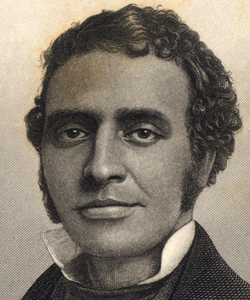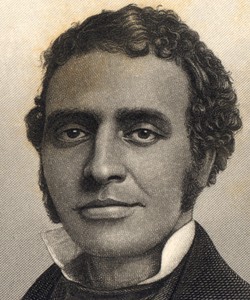
Charles Lewis Reason (July 21, 1818 – August 16, 1893) was a mathematician, linguist, and educator. He became the first African-American university professor at a predominantly white college in the United States, teaching at New York Central College, McGrawville. Charles Lewis Reason was born in New York City as one of three sons to Michel and Elizabeth (Melville) Reason, free people of color (their surname was originally Rison).
They were from Guadeloupe and Saint-Domingue, respectively, and immigrated as refugees in 1793 shortly after the early years of the Haitian Revolution. His brothers were Elwer W. and Patrick H. Reason, who also became leaders. Their older sister Policarpe died in 1818 at age four.
A child prodigy in mathematics, Charles Reason began teaching the subject at the age of fourteen at the African Free School in New York, which he and two of his brothers attended. He next studied at McGrawville College, an integrated institution founded by members of the Baptist Church in McGraw, New York.
In 1847, Reason, along with Charles Bennett Ray, founded the New York-based Society for the Promotion of Education among Colored Children. Two years later, he was appointed professor of belles lettres, Greek, Latin, and French at New York Central College, McGrawville, while also serving as an adjunct professor of mathematics. It was a majority white institution. He was the first African American to serve as a professor at a majority-white college.
In 1852 Reason left that post to become the principal of the Quaker Institute for Colored Youth in Philadelphia (later Cheyney University), a post he held until 1856. During his time there, Reason increased enrollment from six students to 118. Here he favored math and the sciences, but gradually included other areas of study, particularly languages. Seniors expected their grades to appear in the most widely circulated paper in the U.S. black communities: the A.M.E.’s Christian Recorder. Half of the students normally failed to graduate. Though instruction was strict, and exams were rigorous, parents scrambled to register their children.
Reason returned to New York, where he served for decades in public education as a teacher, administrator, and reformer. During this time, he was instrumental in efforts to abolish slavery and segregation. He successfully lobbied for passage of an 1873 statute to integrate New York’s public schools. He was politically active in many community groups.
After the public schools in New York City were desegregated, he became principal of Grammar School No. 80 at 252 West 42nd Street. Although suffering two strokes (one in 1885 and one in 1890) that left him physically incapacitated, Reason continued at his post until he retired, some five months before his death.
Reason was also a poet. He contributed to the Colored American in the 1830s and was a leader of New York City’s Phoenix Society in the 1840s. He wrote the poem “Freedom”, which celebrated the British abolitionist Thomas Clarkson; it was published in Alexander Crummell’s 1849 biography of Clarkson.
Not much documentation has been found on Reason’s personal life, but he was said to have been married and widowed three times. His third and final wife was Clorice (Duplessis) Esteve (1819–1884), whom he married in New York City on July 17, 1855. They had no children, although she had a daughter from her previous marriage to John Lucien Esteve (1809–1852), a French West Indian confectioner, restaurateur and caterer in New York City.
Charles L. Reason died in New York City in 1893 and is buried in Green-Wood Cemetery in Brooklyn.

